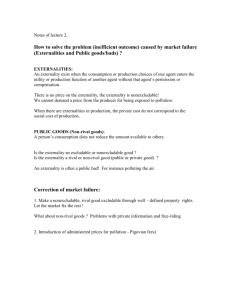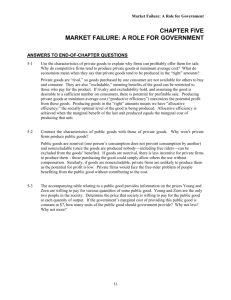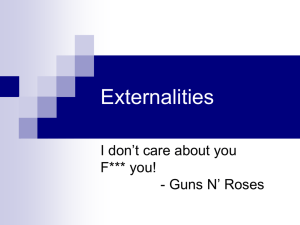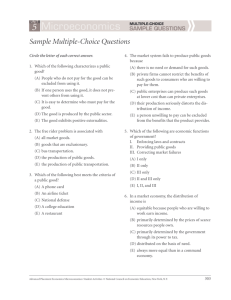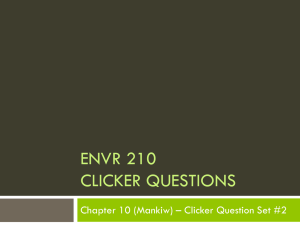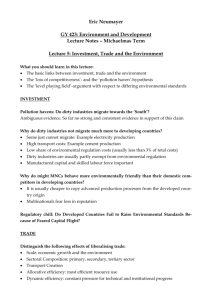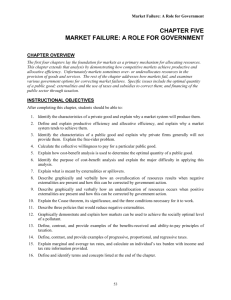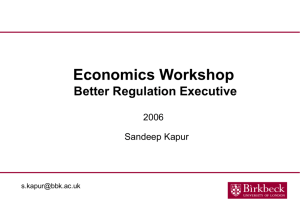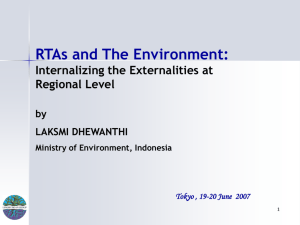Reducing water flow from storm drains has a low marginal
advertisement
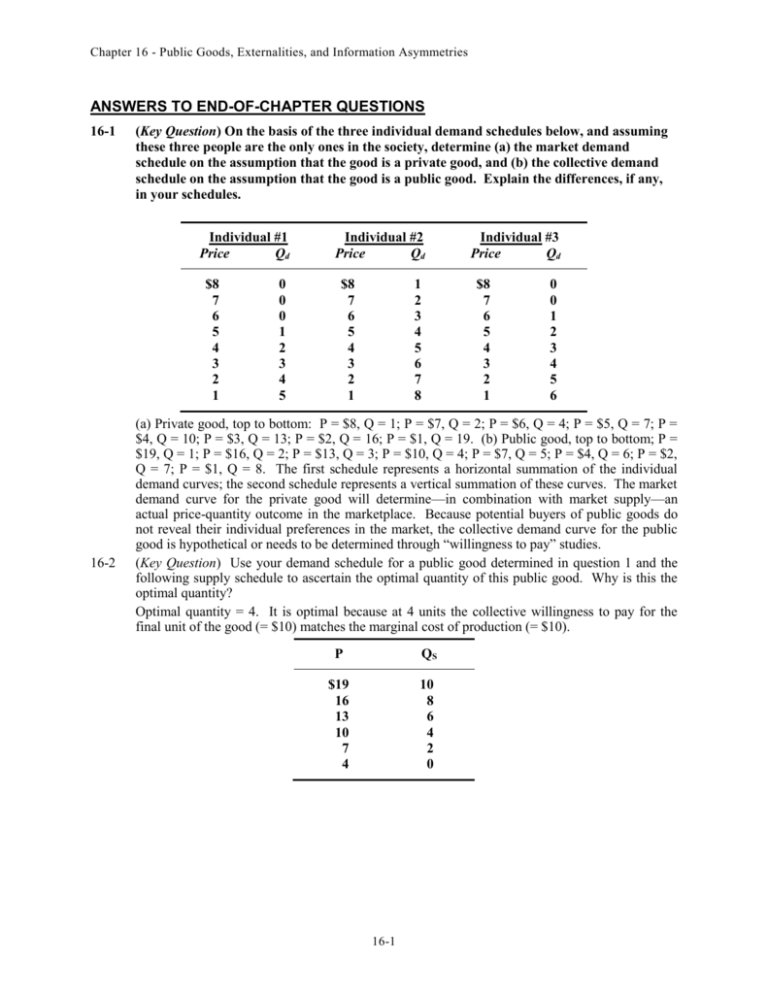
Chapter 16 - Public Goods, Externalities, and Information Asymmetries ANSWERS TO END-OF-CHAPTER QUESTIONS 16-1 (Key Question) On the basis of the three individual demand schedules below, and assuming these three people are the only ones in the society, determine (a) the market demand schedule on the assumption that the good is a private good, and (b) the collective demand schedule on the assumption that the good is a public good. Explain the differences, if any, in your schedules. Individual #1 Price Qd $8 7 6 5 4 3 2 1 16-2 0 0 0 1 2 3 4 5 Individual #2 Price Qd $8 7 6 5 4 3 2 1 1 2 3 4 5 6 7 8 Individual #3 Price Qd $8 7 6 5 4 3 2 1 0 0 1 2 3 4 5 6 (a) Private good, top to bottom: P = $8, Q = 1; P = $7, Q = 2; P = $6, Q = 4; P = $5, Q = 7; P = $4, Q = 10; P = $3, Q = 13; P = $2, Q = 16; P = $1, Q = 19. (b) Public good, top to bottom; P = $19, Q = 1; P = $16, Q = 2; P = $13, Q = 3; P = $10, Q = 4; P = $7, Q = 5; P = $4, Q = 6; P = $2, Q = 7; P = $1, Q = 8. The first schedule represents a horizontal summation of the individual demand curves; the second schedule represents a vertical summation of these curves. The market demand curve for the private good will determine—in combination with market supply—an actual price-quantity outcome in the marketplace. Because potential buyers of public goods do not reveal their individual preferences in the market, the collective demand curve for the public good is hypothetical or needs to be determined through “willingness to pay” studies. (Key Question) Use your demand schedule for a public good determined in question 1 and the following supply schedule to ascertain the optimal quantity of this public good. Why is this the optimal quantity? Optimal quantity = 4. It is optimal because at 4 units the collective willingness to pay for the final unit of the good (= $10) matches the marginal cost of production (= $10). P QS $19 16 13 10 7 4 10 8 6 4 2 0 16-1 Chapter 16 - Public Goods, Externalities, and Information Asymmetries 16-3 16-4 16-5 16-6 (Key Question) The following table shows the total costs and total benefits in billions for four different antipollution programs of increasing scope. Which program should be undertaken? Why? Program Total Cost Total Benefit A B C D $ 3 7 12 18 $ 7 12 16 19 Program B since the marginal benefit no longer exceeds marginal cost for programs that are larger in scope. Plan B is where net benefits—the excess of total benefits over total costs—are maximized. (Key Question) Why are spillover costs and spillover benefits also called negative and positive externalities? Show graphically how a tax can correct for a negative externality and a subsidy to producers can correct for a positive externality. How does a subsidy to consumers differ from a subsidy to producers in correcting for a positive externality? Spillover costs are called negative externalities because they are external to the participants in the transaction and reduce the utility of affected third parties (thus “negative”). Spillover benefits are called positive externalities because they are external to the participants in the transaction and increase the utility of affected third parties (thus “positive”). To show how taxes and subsidies can correct externalities, see Figures 16.3 and 16.4. Compare (b) and (c) in Figure 16.4. An apple-grower’s orchard provides nectar to a neighbor’s bees, while a beekeeper’s bees help the apple grower by pollinating the apple blossoms. Use Figure 16.2b to explain why this situation of dual positive externalities might lead to an underallocation of resources to apple growing and to beekeeping. How might this underallocation get resolved via the means suggested by the Coase theorem? Using Figure 16.2b in the text the following can be said: The market demand curves for apples and honey, Da and Dh, would not include the spillover benefits accruing to the production of the other good. The total benefits associated with the consumption and production of each good could be shown by Dat or Dht and the optimal outputs for each good would be Qao and Qho. Both of these outputs are greater than equilibrium outputs, Qae and Qhe, leading to an underallocation of resources to both apple-growing and beekeeping. Using the Coase theorem, we note that it will be to the advantage of individual apple growers and beekeepers to negotiate so that beekeepers (whose hives can be moved) locate their production in or near orchards. This negotiation will occur as long as property ownership is well defined, only a few people are involved, and bargaining costs are low. For example, an apple grower who owns an orchard could allow a beekeeper to use a portion of his or her land, charging below-market rents so that both parties gain from the agreement. Explain: “Without a market for pollution rights, dumping pollutants into the air or water is costless; in the presence of the right to buy and sell pollution rights, dumping pollution creates an opportunity cost for the polluter.” What is the significance of this fact to the search for better technology to reduce pollution? 16-2 Chapter 16 - Public Goods, Externalities, and Information Asymmetries 16-7 16-8 16-9 The rights to air and water are held in common by society. Without markets for the use of these rights, private individuals will not restrict their polluting activities because there is no monetary incentive to do so. Once these markets are established, the right to pollute will be restricted and have a positive price associated with it. The price represents an explicit monetary cost to polluters, providing them with a tangible incentive to seek ways to cut pollution. This will create potential profits for those who can successfully develop new types of pollution-abatement equipment, accelerating the rate of technological development in this area. (Key Question) Explain the following statement, using the MB curve in Figure 16.6 to illustrate: “The optimal amount of pollution abatement for some substances, say, water from storm drains, is very low; the optimal amount of abatement for other substances, say, cyanide poison, is close to 100 percent.” Reducing water flow from storm drains has a low marginal benefit, meaning the MB curve would be located far to the left of where it is in the text diagram. It will intersect the MC curve at a low amount of pollution abatement, indicating the optimal amount of pollution abatement (where MB = MC) is low. Any cyanide in public water sources could be deadly. Therefore, the marginal benefit of reducing cyanide is extremely high and the MB curve in the figure would be located to the extreme right where it would intersect the MC curve at or near 100 percent. Explain the tragedy of the commons, as it relates to pollution. The “tragedy of commons” is the tendency for society to overuse and thus abuse common resources when no one holds property rights. A common pasture in which anyone can graze cattle will quickly be overgrazed. Profit-seekers will choose the least-cost combination of inputs and bear only unavoidable costs. If they can dump waste without paying for proper disposal individuals, firms—and even government agencies—are likely to do so, because it is cheap and convenient. What is the climate-change problem? Using an example other than the one in the text, explain how climate change might hurt one industry, particular region, or country but help another. Distinguish between a carbon tax and a cap-and-trade strategy for reducing greenhouse gases. Which of the two strategies do you think would have the most political support in an election in your home state? Explain your thinking. Scientific evidence suggests that carbon dioxide and other gas emissions are accumulating and causing the average temperature of the atmosphere to increase. In the Kyoto Protocol, the industrialized nations agreed to cut emissions 6 to 8 percent below 1990 by 2012. Flooding may occur in some regions, thus decreasing the land upon which the population lives, whereas temperatures in the northern parts of the globe may moderate and make these areas more habitable. (Al Gore’s film An Inconvenient Truth illustrates this effectively.) A carbon-tax affects each polluting firm by charging them for emissions. The cap-and-trade strategy would allow more efficient firms to sell their permits to the less efficient firms resulting in greater efficiency (Heavier polluters must pay more to maintain the same level of production). 16-3 Chapter 16 - Public Goods, Externalities, and Information Asymmetries 16-10 Explain how marketable emissions credits add to overall economic efficiency, compared to across-the-board limitations on maximum discharges of air pollutants by firms. If company A can reduce pollution by 1 ton at less cost than company B, then company B should buy emission credits from company A. In doing this, society is using fewer resources (spending fewer dollars) to achieve the same level of pollution reduction. 16-11 Why is it in the interest of new homebuyers and builders of new homes to have government building codes and building inspectors? The reason is related to the lack of information and education on the part of most new homebuyers and builders with regard to every aspect of home construction. To make sure that a new building conforms to adequate safety and construction standards, building codes have been created. The government inspectors provide impartial third-party expertise to assure the buyer that the codes have been met. Such inspections also provide information to builders about the electrical and plumbing installation that is usually done by subcontractors. Without building codes and inspections, the market for new homes might be severely hampered. Builders thus also benefit from codes and inspectors. 16-12 (Key Question) Place an “M” beside items in the following list that describe a moral hazard problem and an “A” beside those that describe an adverse selection problem. a. A person with a terminal illness buys several life insurance policies through the mail. b. A person drives carelessly because he or she has automobile insurance. c. A person who intends to “torch” his warehouse takes out a large fire insurance policy. d. A professional athlete who has a guaranteed contract fails to stay in shape during the off-season. e. A woman anticipating having a large family takes a job with a firm that offers exceptional child-care benefits. Moral hazard problem: (b) and (d). Adverse selection problem: (a), (c), and (e). 16-13 (Last Word) Explain how a global-positioning antitheft device installed by one car owner can produce a positive externality to thousands of others in a city. If a car with the device is stolen, police can track the stolen car, possibility arresting the theft and preventing him/her from stealing other cars. Also, the police might be able to track the car to a “chop shop,” thus putting an entire ring of thefts out of business. 16-4


